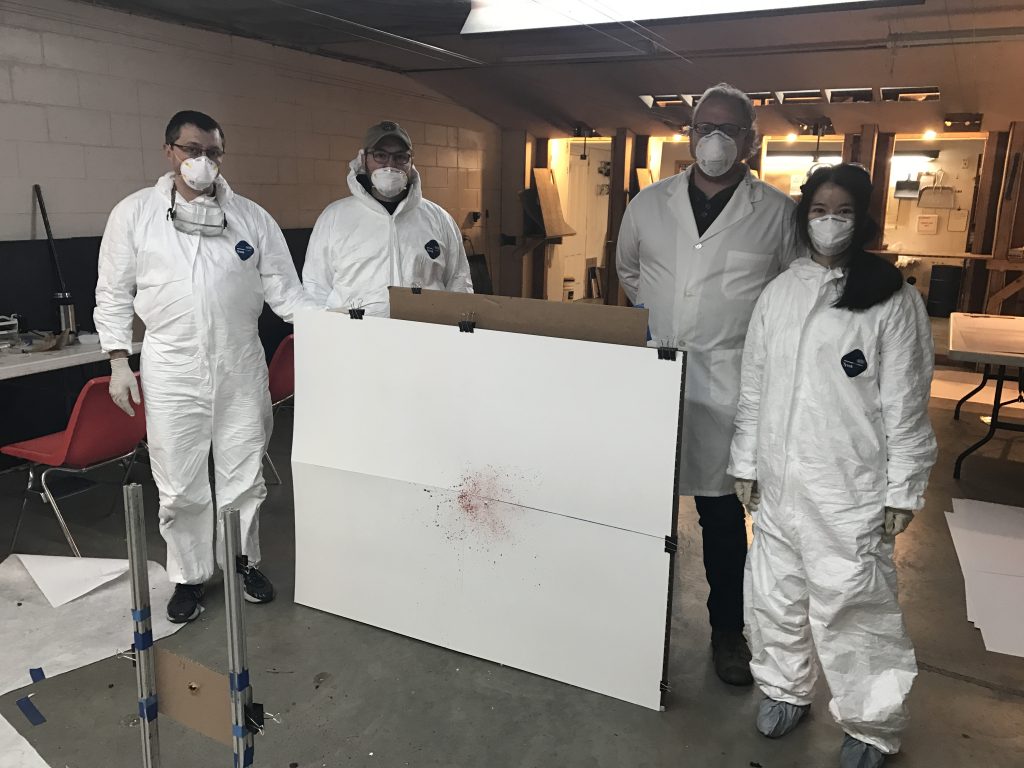Interdisciplinary research is a key value of the development of human knowledge, according to CSAFE researcher and Iowa State University associate professor of mechanical engineering Dr. Daniel Attinger. This philosophy is the foundation that led to the development of a new dataset of bloodstain patterns, now publicly available to the forensic science community, researchers and educators.
A 2009 National Academies of Science and Engineering report revealed that the uncertainties in the field of bloodstain pattern analysis are enormous, and called for the development of more accurate methods.
Fields of Study Coming Together
In order to quantify the rate of error associated with current techniques in blood pattern analysis, CSAFE has assembled a world-class interdisciplinary team of experts in statistical learning, fluid dynamics and pattern recognition.
Combining the fields of mechanical engineering, statistics and computer science has led researchers to develop new methods and techniques not possible within each individual discipline.
“Collaborators in other fields help with challenges you have thought of addressing for a long time, but never found the right tool to work with,” Attinger said.
Dr. Kris De Brabanter, CSAFE researcher and ISU assistant professor of statistics adds, “At first it’s challenging and perhaps even scary since one is getting pulled out of their respective fields. Once those barriers are crossed, a new world suddenly opens that you never knew existed. At the end it makes each individual a stronger researcher.”
Investigating Sources of Error
Together, the CSAFE team is assessing the amount of error in blood stain pattern analysis findings by investigating two problems. One, is classification.
“Classification means you have an unknown object or unknown situation, in our case it’s an unknown blood pattern,” Attinger said. “We are trying to see if this blood pattern has been created by a gunshot or a beating because those are two of the current situations when you have a criminal activity.”
The second goal is to determine where the blood stains came from.
“If you see a bunch of stains on the ceiling or on the walls an important aspect of the crime scene reconstruction is to figure out where was the source of the blood that was atomized that traveled through the air and then that produced the stain,” Attinger said.
According to Attinger, answering that question can increase the validity of courtroom testimony.
For example, he said, “If the alleged aggressor says ‘we were standing and fighting’ but if you can prove that the blood has come from a very low height that might actually mean that the person was lying upon the carpet or the floor and was beaten to death by the aggressor.”
Another example is being able to determine if one blow or several occurred over a certain amount of time. Knowing these variables can lead to more appropriate sentencing.
Currently, there’s still a lack of physical understanding of how the blood drop travels in the air and how the blood is broken into small drops.
“The methods that are used to determine where the blood came from are a bit simplistic in terms of the physics that is included,” Attinger said. “For example they neglect things like drag and gravity and they assume that the drops travel in straight lines.”
Developing new tools in bloodstain pattern analysis
To address these issues, researchers have combined statistical learning techniques with fluid dynamics principles to produce a data set of 61 blood spatter patterns. Each blood spatter pattern was generated by controlled impact events corresponding to forensic beating situations. Researchers varied the geometry and speed of the impact of a solid object on a pool of blood. The resulting blood droplets travelled a set distance towards a poster board sheet, creating a blood spatter. Fresh swine blood was used and its hematocrit and temperature were measured. The results were recently published in “Data in Brief”.
“The high-resolution blood spatter database that we have built is providing a consistent set of data using controlled and carefully documented experiments,” said Attinger and De Brabanter. “This database has been shared with researchers worldwide so that every group can test their backward trajectory reconstruction methods, to identify the region of origin of the blood spatter and to determine the blood pattern generation mechanism.”
The published data systematically documents the experimental conditions and also helps dissemination of blood spatters for teaching and instructional purposes, which otherwise may be difficult. This database provides provide blood pattern analysis instructors with a safe set of spatters ready to be printed for their classes.
“One of the simplest ways to move science forward is to generate data and share it,” Attinger said. “It’s very time consuming for researchers to always re-do their own data, so we really hope the data we published will be useful to many colleagues.”
CSAFE plans to integrate its blood spatter data into current resources available at the National Institute of Standards and Technology, and potentially integrate the data into a commercially viable software package.
Learn more and review the full Data in Brief publication.




